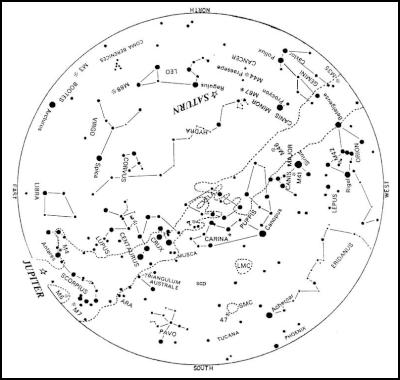The April Night Sky
The Night Sky
Brian Carter *Carter Observatory
The National Observatory Of New Zealand
THE APRIL NIGHT SKY
We are well past the time where the nights became longer than the days. The length of the nights will continue to increase until late June.
Planets
April is a good month for viewing the planets. Venus, Mars, Jupiter and Saturn will be visible for all of the month and Mercury for all but the end of the month.
Venus will be visible in the evening sky. At the start of the month it sets at 19 40 and at 19 35 by month’s end. Venus starts the month in the constellation of Aries, moving into Taurus on April 9. Its brilliant magnitude slightly increases from –4.0 to –4.1 during April.
Saturn will be visible for the first half of the night. At the start of the month it sets at 02 15 and at 00 20 by month’s end. Saturn is in the constellation of Leo, in which it remains until September 2009. Its magnitude slightly fades from 0.2 to 0.4 during the month.
Jupiter will be visible for all but the start of the night. At the start of the month it rises at 21 31 and at 19 34 by month’s end. Jupiter is in the constellation of Ophiuchus, in which it remains until 2007 December. Its magnitude increases from –2.3 to –2.5 during the month.
Mars will be visible for the last quarter of the night. It rises at 02 45 for the whole of April. Mars start the month in the constellation of Capricornus, moving into Aquarius on April 4. Its magnitude slightly brightens from 1.1 to 1.0 during the month.
Mercury is visible in the morning sky for all but the latter part of April. At the start of the month it rises at 04 22, at 05 59 (an hour before Sunrise) by April 23 and at 06 46 (only 20 minutes before Sunrise) by month’s end. Mercury starts the month in the constellation of Aquarius, moving into Pisces on April 10, into Cetus on April 16, back into Pisces on April 19 and finally into Aries on April 28. It magnitude rapidly brightens in the month from 0.0 to –1.8.
All times are for Wellington unless otherwise stated. Other centres may vary by a few minutes.
Phases of the Moon
Full Moon – April 3 at
05 15.
Last Quarter – April 11 at 06 04.
New Moon
– April 17 at 23 36.
First Quarter – April 24 at 18
36.
Diary of Astronomical Phenomena
Apr 3 Full Moon
at 05 15.
3 Moon at apogee (furthest from the Earth) at
21:00 (Distance = 0.0027161 AU = 406,320 km).
6 Jupiter
stationary against the background stars at 14 00, as its
motion changes from an Easterly to a Westerly
direction.
8 Antares 0.6°N of Moon at 01
00.
8 Jupiter close to the Moon at 21 00, soon after they
rise.
17 Moon at perigee (closest to the Earth) at 18:00.
(Distance = 0.0023873 AU = 357,130 km).
17 New Moon at 23
36.
20 Saturn stationary against the background stars at
13 00, as its motion changes from a Westerly to an Easterly
direction.
20 Venus close to the Moon as they both set
around 19 00.
25 Saturn 1°S of Moon at 22 00.
26
Regulus 1°S of Moon at 21 00.
30 Moon at apogee
(furthest from the Earth) at 23:00 (Distance = 0.0027153 AU
= 406,200 km).
APRIL SKY CHART
This chart shows the sky as it appears at about 21:00 for ~April 15.

Click to enlarge
How To Use the Sky
Charts
To use the sky chart hold it up to the sky so that
the direction in which you are looking is at the lower edge
of the map. For example, if you are looking at the western
horizon then the map should be held so that the “WEST”
label is at the lower edge. The altitude and direction of
the stars and planets will then be correctly shown. The
centre of the chart will be directly overhead.
If you
would like to receive Carter Observatory’s full
e-Newsletter, please email to
Astronomy[at]carterobservatory.org to be included on the
list.
* Brian Carter is the Senior Astronomer at Carter Observatory (The National Observatory of New Zealand), PO Box 2909, Wellington. (Observatory Web Site: www.CarterObservatory.org)


 Peter Dunne: Luxon Gets Out His Butcher's Knife - Briefly
Peter Dunne: Luxon Gets Out His Butcher's Knife - Briefly Binoy Kampmark: Warring Against Encryption, Australia Is Coming For Your Communications
Binoy Kampmark: Warring Against Encryption, Australia Is Coming For Your Communications Gordon Campbell: On Fast Track Powers, Media Woes And The Tiktok Ban
Gordon Campbell: On Fast Track Powers, Media Woes And The Tiktok Ban Binoy Kampmark: Censorship Wars, Elon Musk, Safety Commissioners And Violent Content
Binoy Kampmark: Censorship Wars, Elon Musk, Safety Commissioners And Violent Content Gordon Campbell: On The Public Sector Carnage, And Misogyny As Terrorism
Gordon Campbell: On The Public Sector Carnage, And Misogyny As Terrorism Ramzy Baroud: NATO’s Never-ending War: The 75-Year-Old Bully Is Faltering
Ramzy Baroud: NATO’s Never-ending War: The 75-Year-Old Bully Is Faltering